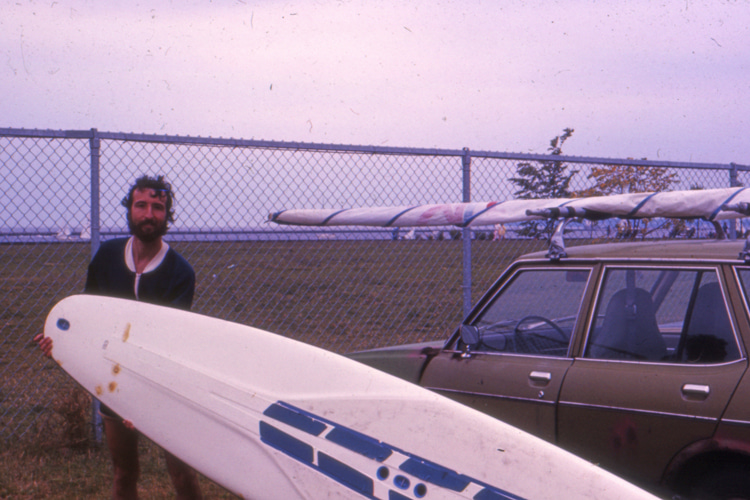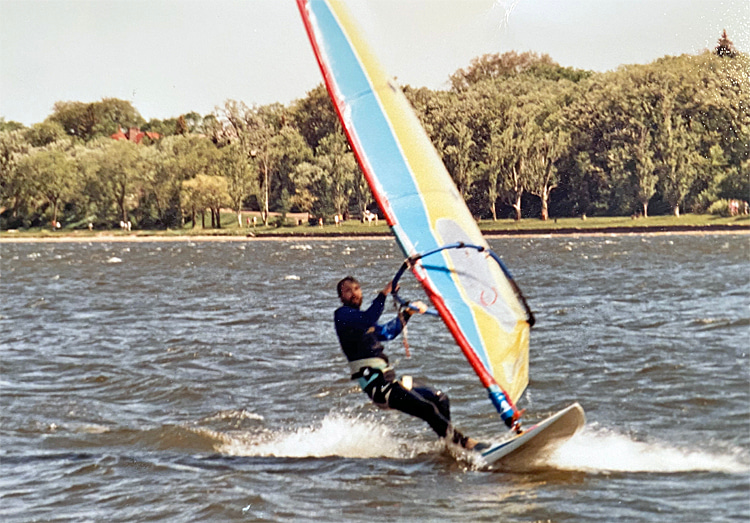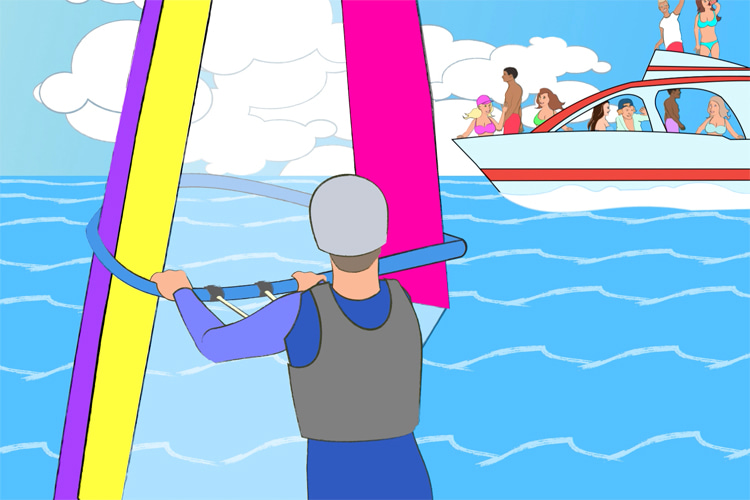My name is Mark Fiore Martino. I learned to windsurf in 1979.
My favorite spot is Waverly Beach, near our home in Kirkland, Washington. I moved there because jobs were plentiful, but mostly so I could sail the Gorge a lot, which I did.
Lately, I've slowed down. Fifty-five-degree water is more daunting now that I'm 69.
Kenosha, Wisconsin, where I was born, is also the birthplace of my windsurfing passion.
At 29, I moved back to Wisconsin from San Jose, California, where I had been hang gliding, until I noticed that even experienced pilots crash, sometimes fatally.
When I saw a windsurfer on Pewaukee Lake, I thought, "Hey, that looks exciting and a lot safer."
So I took my first lesson from her.
After two hours of flailing and falling, I got my first ride. It was only a couple hundred feet, but it was amazing.
I was cold, exhausted, and hooked on windsurfing.
That summer, I took electrical engineering classes in the morning, windsurfed in the afternoon, and danced in discos at night.
Awesome summer!

An Artistic Background
A lot went on before that. My father, Palmer Martino, a commercial artist, taught my sister Linda, my brothers Mike and Jim, and me to draw and paint signs.
My brother Michael excelled at both, even more so at sculpting. His outdoor bronze sculptures are on display in Milwaukee, Chicago, and other places.
Linda got a degree in fashion design and worked for clothing manufacturers in Milwaukee.
Jim's a software engineer and the only sibling who understands my engineering rants.
Using the art skills my dad taught me, I got jobs to finance getting an art degree from the University of Wisconsin-Milwaukee (UW-M).
I worked as a cartoonist, sign painter, set designer and builder, graphic designer, technical illustrator, drafter, and circuit board designer.
I financed my BSEE from UW-M with the money I made.
Then I worked as an electronics engineer, software engineer, computer graphics engineer, game scene programmer, screenwriter, and movie producer.
I bounced from startup to startup.

Windsurfing and Animation
Whenever I could, I was cartooning, screenwriting, animating, and making movies. Over about 15 years, I wrote and pitched over a dozen screenplays.
Then, I spent about $16,000 of my own money to produce two comedy shorts.
I had no more money to spare, so I needed a way to make movies from my screenplays cheaply.
Three years ago, I found the tool that lets me do that: Apple Keynote.
After making a bunch of animated cartoons with Keynote, I decided to combine the two things I love to do: windsurf and animate.
I had already written a romantic comedy about windsurfing called "Beach Baby," so I came up with a plan to turn it into a cartoon series.
Beach Time
It's called "Beach Time."
Each episode is a funny story set on a beach that feels magical yet familiar. It took me a couple of months to refine the idea and design a production process.
Over the next six months, I worked on "Episode 1 - Escape to the Lake."
I put it up on the MoviesByMartino YouTube channel and started "Episode 2 - Rather Be Windsurfing."
Five months later, I published that one. I'm about a third of the way through Episode 3.
As I do each episode, I make elements I can reuse in other episodes and learn ways to speed up the process.
I'm working towards publishing one episode a month.
Since "Beach Baby" is a feature-length screenplay, I've got plenty to work with, possibly twenty or more episodes.
The Animation Method
Developing an episode goes like this: I combine new ideas with stuff from the "Beach Baby" screenplay to create the screenplay for an episode.
An episode can be two to five minutes long.
I copy the text from the screenplay into a Keynote file. I break the text into shots by moving a few lines of text at a time into slides.
Then, I record the dialogue on each slide in Keynote.
I do voices the way standup comedians do them when they are telling stories.
Sometimes for female characters, I'll ask an actor to record them or use one of the artificial voices on my Mac.
When the dialogue is pretty much done, I draw and animate each slide to make the shots. I use the vector drawing and animation tools in Keynote.
Then, I make sounds and music using GarageBand.
Along the way, I generate videos using Keynote's export to movie feature. I also make video clips with transparent backgrounds so I can layer them into the main video.
When it's all done, I generate a final MP4 file.
I love using Keynote because I can make changes to the story, the art, the animation, and the sound at any time during the process.
I've learned lots of Keynote tricks and post them on LinkedIn.
Because Keynote is a simple tool compared to full-on 2D and 3D animation and video tools, it keeps me from getting too bogged down in the technical aspects.
That way, I get to stay in touch with the story and the emotional and artistic aspects of it.
Words by Mark F. Martino | Creator of the "Beach Time" series
